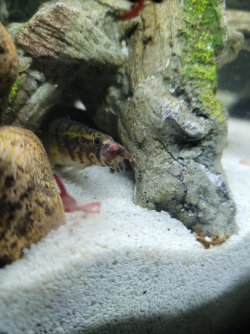Finchflight
New Member
Hey everyone, I joined this website to hopefully find a way to save my zebra spiny eel. I've had him for 2 years and I love him so much...
I have a 75 gallon freshwater tank with two 75 gallon filters. All parameters are correct. Inhabitants in the tank include the zebra spiny eel, 3 angelfish, and some scissortail tetras. The eel and the other fish eat thawed brine shrimp and blood worms (if necessary I plan on switching to live as my eel grows). The substrate is sand for my eel to burrow in and I have made sure that he has a lot of places to hide ever since he came into my life.
About 2 weeks ago, I noticed that he started breathing with his mouth open. Fearing injury and/or bacterial infection I began more frequent water changes with a daily dose of Melafix. A week into treatment, I noticed that he is breathing slower. I continue treatment but noticed that he has developed growths on his face that seem to be preventing him from closing his mouth and eating. He seems to try and grab the worms/shrimp but cannot get them in his mouth. I pray that he is eating when I am not looking. I cannot find out what is wrong nor how to treat it. Please help me save him, I love him dearly. I have attached a photo below that I just took tonight at feeding time.
I have a 75 gallon freshwater tank with two 75 gallon filters. All parameters are correct. Inhabitants in the tank include the zebra spiny eel, 3 angelfish, and some scissortail tetras. The eel and the other fish eat thawed brine shrimp and blood worms (if necessary I plan on switching to live as my eel grows). The substrate is sand for my eel to burrow in and I have made sure that he has a lot of places to hide ever since he came into my life.
About 2 weeks ago, I noticed that he started breathing with his mouth open. Fearing injury and/or bacterial infection I began more frequent water changes with a daily dose of Melafix. A week into treatment, I noticed that he is breathing slower. I continue treatment but noticed that he has developed growths on his face that seem to be preventing him from closing his mouth and eating. He seems to try and grab the worms/shrimp but cannot get them in his mouth. I pray that he is eating when I am not looking. I cannot find out what is wrong nor how to treat it. Please help me save him, I love him dearly. I have attached a photo below that I just took tonight at feeding time.


